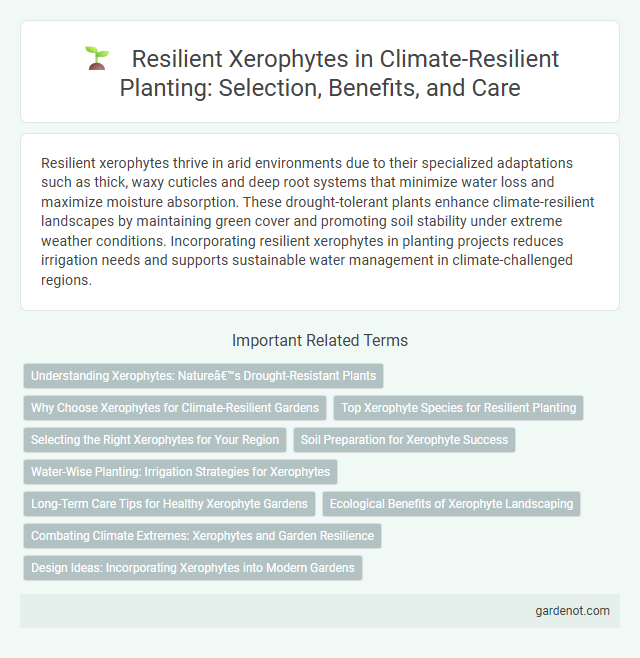Resilient xerophytes thrive in arid environments due to their specialized adaptations such as thick, waxy cuticles and deep root systems that minimize water loss and maximize moisture absorption. These drought-tolerant plants enhance climate-resilient landscapes by maintaining green cover and promoting soil stability under extreme weather conditions. Incorporating resilient xerophytes in planting projects reduces irrigation needs and supports sustainable water management in climate-challenged regions.
Understanding Xerophytes: Nature’s Drought-Resistant Plants
Xerophytes are specialized plants adapted to survive in arid environments by efficiently conserving water through features such as thick cuticles, reduced leaf surface area, and deep root systems. These drought-resistant plants play a crucial role in climate-resilient planting strategies by stabilizing soils and maintaining ecosystem balance in regions prone to water scarcity. Incorporating xerophytes into landscaping and restoration projects enhances biodiversity and ensures sustainable vegetation growth under harsh climatic conditions.
Why Choose Xerophytes for Climate-Resilient Gardens
Xerophytes are ideal for climate-resilient gardens due to their exceptional ability to thrive in arid conditions with minimal water, reducing irrigation needs and conserving resources. Their adaptive features, such as thick cuticles and deep root systems, enhance drought tolerance and soil stabilization, promoting sustainable landscaping. Choosing xerophytes mitigates the impacts of climate variability by ensuring plant survival during prolonged dry spells and extreme heat events.
Top Xerophyte Species for Resilient Planting
Top xerophyte species for resilient planting include Agave americana, Aloe vera, and Opuntia ficus-indica, known for their exceptional drought tolerance and ability to thrive in arid climates. These species possess specialized adaptations such as thick cuticles, water-storing tissues, and CAM photosynthesis that enhance water use efficiency and survival under extreme heat and low moisture conditions. Integrating these xerophytes into landscaping and restoration projects significantly improves ecosystem resilience against climate variability and prolonged drought periods.
Selecting the Right Xerophytes for Your Region
Selecting the right xerophytes for your region involves analyzing local climate conditions, soil type, and water availability to ensure optimal growth and drought resistance. Native xerophyte species adapted to regional stressors provide enhanced climate resilience by minimizing water usage and improving ecosystem stability. Incorporating these plants into landscaping or restoration projects supports sustainable greenery and reduces the need for irrigation in arid and semi-arid environments.
Soil Preparation for Xerophyte Success
Effective soil preparation for resilient xerophytes involves improving soil texture by incorporating coarse sand and organic matter to enhance drainage and nutrient retention. Amending soil with biochar can increase moisture-holding capacity while promoting beneficial microbial activity essential for xerophyte survival. Ensuring proper soil pH balance between 6.0 and 7.5 supports optimal nutrient uptake and root development crucial for drought-tolerant plants.
Water-Wise Planting: Irrigation Strategies for Xerophytes
Xerophytes exhibit exceptional drought tolerance through deep root systems and reduced transpiration, making them ideal for climate-resilient planting in arid regions. Implementing drip irrigation and moisture sensors optimizes water use efficiency, ensuring that these plants receive precise hydration without waste. Water-wise planting strategies not only conserve scarce water resources but also enhance xerophytes' survival and growth in increasingly dry climates.
Long-Term Care Tips for Healthy Xerophyte Gardens
Xerophyte gardens thrive with well-drained soil and minimal watering, mimicking their natural arid environments. Annual pruning and removal of dead foliage prevent disease and promote healthy growth in drought-resistant plants. Mulching with gravel or sand helps retain moisture and stabilize soil temperature for long-term xerophyte resilience.
Ecological Benefits of Xerophyte Landscaping
Xerophyte landscaping enhances climate resilience by conserving water and reducing soil erosion in arid environments. These drought-tolerant plants improve biodiversity by providing habitat for native pollinators and wildlife. Integrating xerophytes also lowers urban heat islands, contributing to microclimate regulation and sustainable ecosystem services.
Combating Climate Extremes: Xerophytes and Garden Resilience
Xerophytes exhibit remarkable adaptations such as deep root systems, thick cuticles, and reduced leaf surfaces that enable them to thrive in arid environments while conserving water. These resilient plants significantly enhance garden resilience by maintaining green cover and reducing soil erosion during prolonged droughts and extreme heat. Integrating xerophytes into landscaping supports biodiversity and climate adaptation strategies, making outdoor spaces more sustainable amid increasing climate extremes.
Design Ideas: Incorporating Xerophytes into Modern Gardens
Incorporating resilient xerophytes such as agave, aloe, and lavender into modern gardens enhances climate resilience by reducing water consumption and soil erosion. Design ideas include using layered rock beds, mixed-texture plantings, and drought-tolerant ground covers to create visually striking, sustainable landscapes. These xerophytes thrive in arid environments, making them ideal for sustainable urban greening and xeriscaping projects.
Resilient xerophyte Infographic

 gardenot.com
gardenot.com